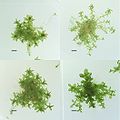| Physcomitrella patens | |
|---|---|
 | |
| Scientific classification | |
| Kingdom: | Plantae |
| Division: | Bryophyta |
| Class: | Bryopsida |
| Subclass: | Funariidae |
| Order: | Funariales |
| Family: | Funariaceae |
| Genus: | Physcomitrella |
| Species: | P. patens |
| Binomial name | |
| Physcomitrella patens | |
| Synonyms [1] | |
Physcomitrella patens is a synonym of Physcomitrium patens, [2] [3] the spreading earthmoss. [4] It is a moss, a bryophyte used as a model organism for studies on plant evolution, development, and physiology. [3]






